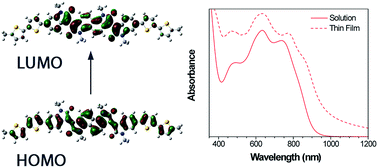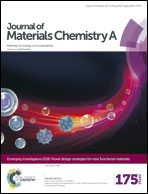Bisisoindigo: using a ring-fusion approach to extend the conjugation length of isoindigo†
Abstract
The synthesis of bisisoindigo, a near IR absorbing electron acceptor in which two isoindigo units are ring-fused along the 6 and 7 positions, is reported. An electron-deficient bisisatin was first synthesized using the Martinet isatin synthesis, after which two concurrent aldol condensations with 1-alkyl-2-oxindole yielded the ring-fused isoindigo dimer. The ring fusion significantly extends the conjugation length of the molecule relative to the isoindigo parent compound. The bisisoindigo sub-unit was then coupled to 2,2′-bithiophene, yielding a new organic semiconductor with a donor–acceptor structure. Both bisisoindigo and the donor–acceptor compound absorb light well into the near IR; the donor–acceptor compound features an absorption edge of almost 1000 nm in the solid state. Both compounds were employed in prototype organic photovoltaic devices alongside common electron donors and acceptors.

- This article is part of the themed collection: Emerging Investigators 2016: Novel design strategies for new functional materials

 Please wait while we load your content...
Please wait while we load your content...